Like fellow suburban area Denton, Collin County is quickly becoming a hot living destination in the Lonestar State. As one of the lynchpins in the Dallas-Fort Worth metroplex, Collin County offers an escape from the urban sprawl of DFW. Thanks to the growth of Dallas, Tarrant, and Denton counties, Collin County is part of one of the United States’ most dynamic economies. The county is more than just a suburb, however, and is quickly developing a commercial sector as well, putting another feather in its cap.
This demand and growth do have some downsides, most notably a rise in taxable value for homes, businesses, and even empty land. This has put taxpayers into direct conflict with the Collin Central Appraisal District (CCAD). While true property values are certainly rising, many see CCAD as using this as an excuse for over taxation. In response, a growing number of residents are pursuing property tax appeals. These protests can help lower values on real estate of all types, helping those that wish to keep their properties retain ownership at a reasonable tax rate. These protests have been making strides in Collin County, demonstrating why they are useful and why every Texan should explore their constitutional right to stand up to their appraisal district. In this article, we will see how taxpayers have done in 2025 and how those that joined O’Connor benefited the most from their appeal journey.
O’Connor Clients Cut $59 Million from Taxable Home Value
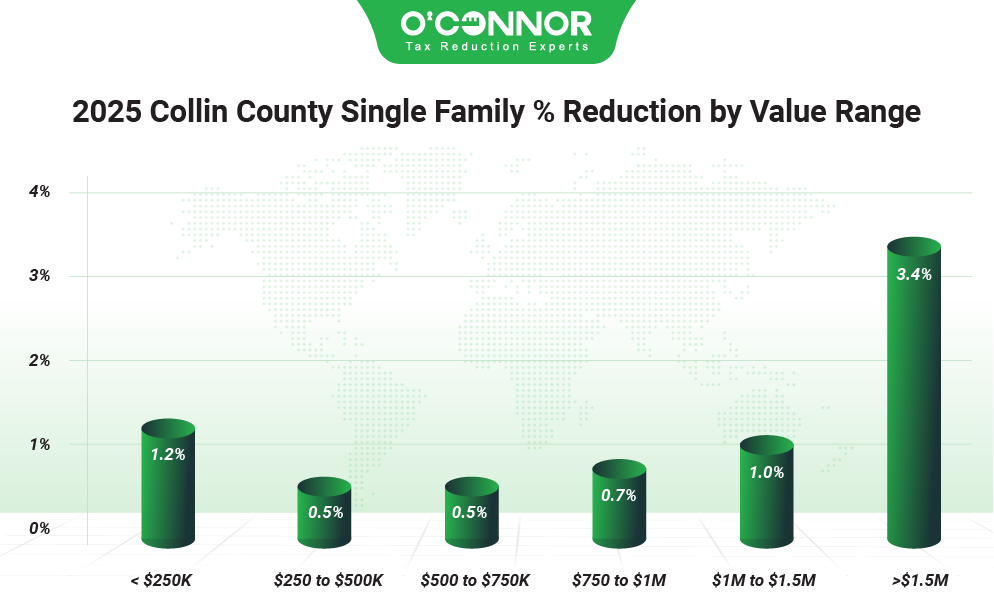
CCAD estimated that 22% of homes were overvalued in 2025, which was an improvement from 28% in 2024. After a hike of 4.9%, the combined value of all single family homes in Collin County was assessed at $196.96 billion. This spike was partially cut into by appeals, which caused a decrease of 0.9%. Most value was generated by homes worth between $500,000 and $750,000, which totaled $65.86 billion after a small reduction of 0.5%. Those assessed between $250,000 and $500,000 were in second place with $55.88 billion after another 0.5% reduction. In third place were homes worth between $750,000 and $1 million, which achieved a total of $33.03 billion after a decrease of 0.7%. Homeowners that took their protest to O’Connor were able to save 1.4% on their combined total, including 1.2% on residences worth between $500,000 and $750,000. This produced a total value saving of $59.52 million.
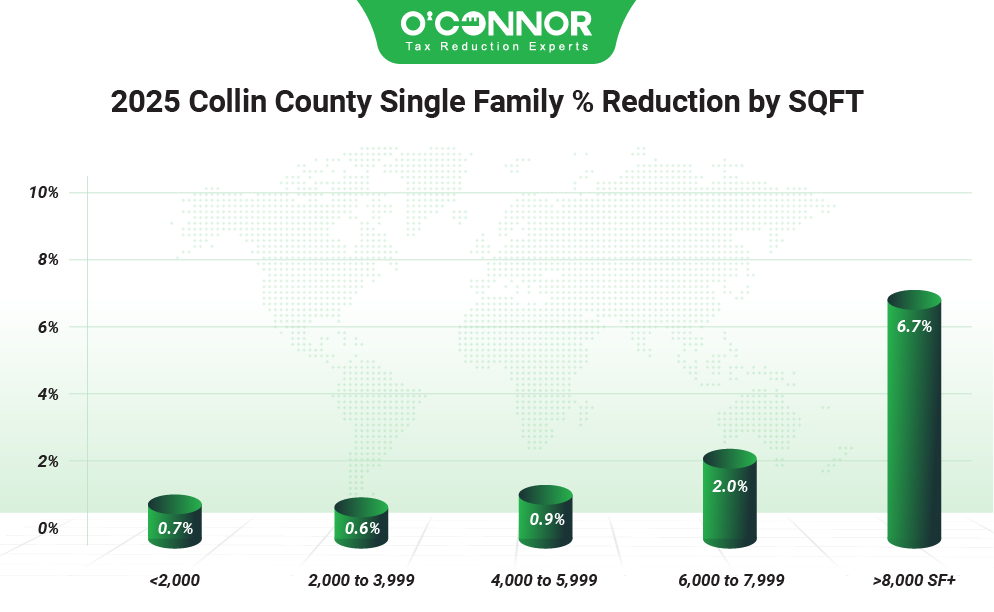
Despite there being an abundance of high-dollar properties, the majority of Collin County homes were actually of a modest size, illustrating just how much every piece of real estate is worth. Residences between 2,000 and 3,999 square feet were the largest block by far, with a total of $121.50 billion in total value after a reduction of 0.6% thanks to appeals. Larger homes between 4,000 and 5,999 square feet were in second with $34.55 billion, including an appeal decrease of 0.9%. The smallest homes were in third place and still managed a large total of $32.12 billion. True luxury homes, those between 6,000 and 7,999 square feet and those even bigger, accounted for just $4.43 billion and $3.66 billion respectively.
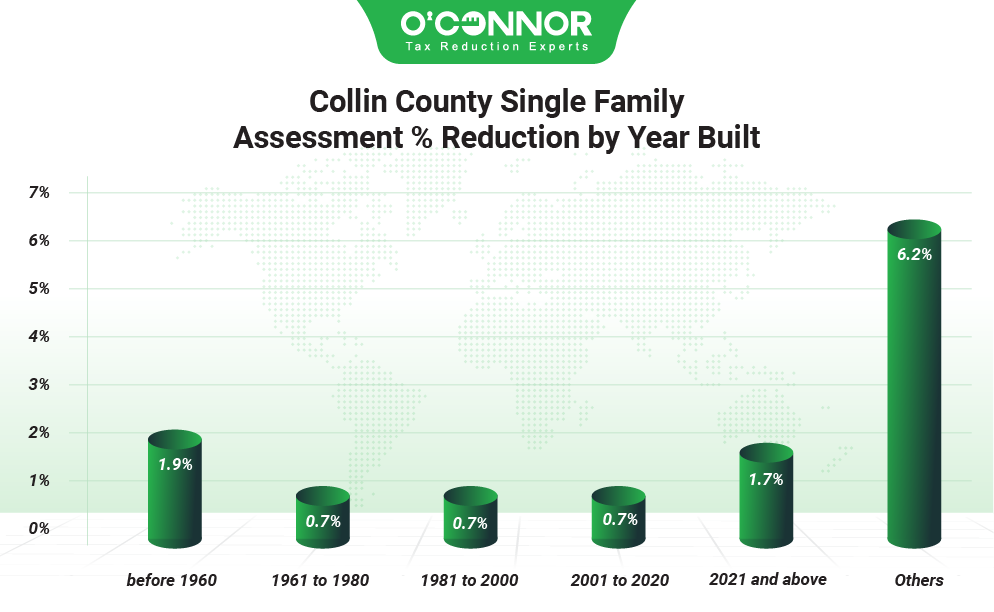
As Collin County has gone through a transition in the past few decades, the majority of residential value was constructed recently. The most valuable timeframe was from 2001 to 2020, where 47.2% of all value was created, totaling $93.20 billion. These homes were eventually protested down by 0.7%. $59.70 billion was built between 1981 and 2000, while new construction was already responsible for $28.09 billion. These were cut by appeals for 0.7% and 1.7% respectively. Raw land and other buildings only accounted for a total of 7.9% of all value, solidifying the country’s reputation as a trendy up-and-comer.
Appeals with O’Connor Slice 9.6% from Commercial Properties
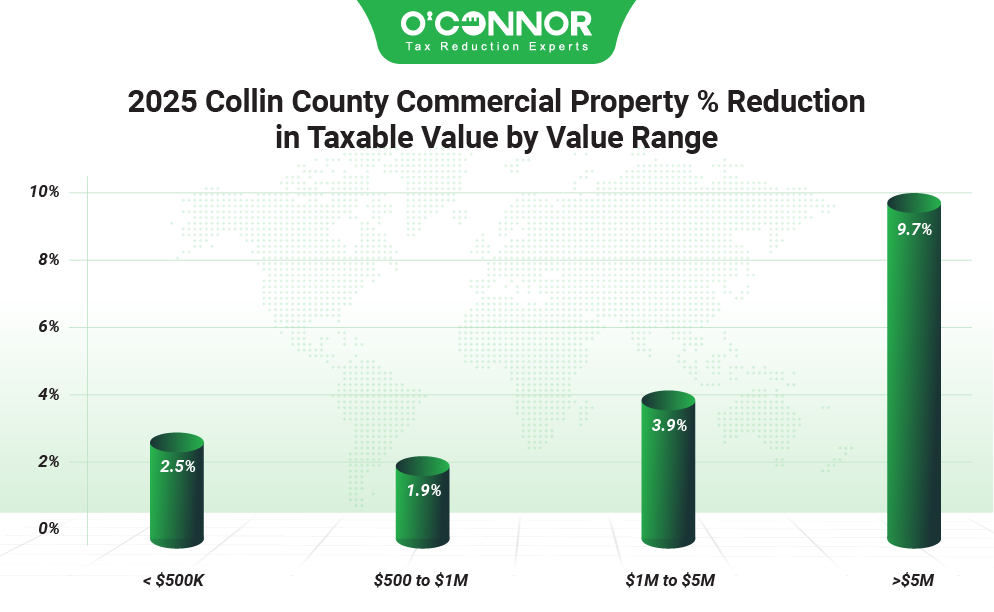
Collin has quietly become a much stronger commercial county in the past few years, with business property values improving drastically in the past decade. Value shot up 14.8% in 2025 alone, a capstone on a rising trend. This resulted in an initial total of $71.70 billion, before a litany of appeals brought that number down by 8.7%. The largest block of value, as is typical in Texas, was commercial properties worth over $1.5 million. These tallied a combined value of $53.61 billion after a substantial cut of 9.7% thanks to protests. This was followed distantly by those worth between $1 million and $1.5 million, which reached $8.91 billion after a cut of 3.9%. O’Conner partnered with our clients to land an overall reduction of 9.6%, including an 11% decrease for businesses worth over $1.5 million. When combined, we managed to help customers save $54.78 million.
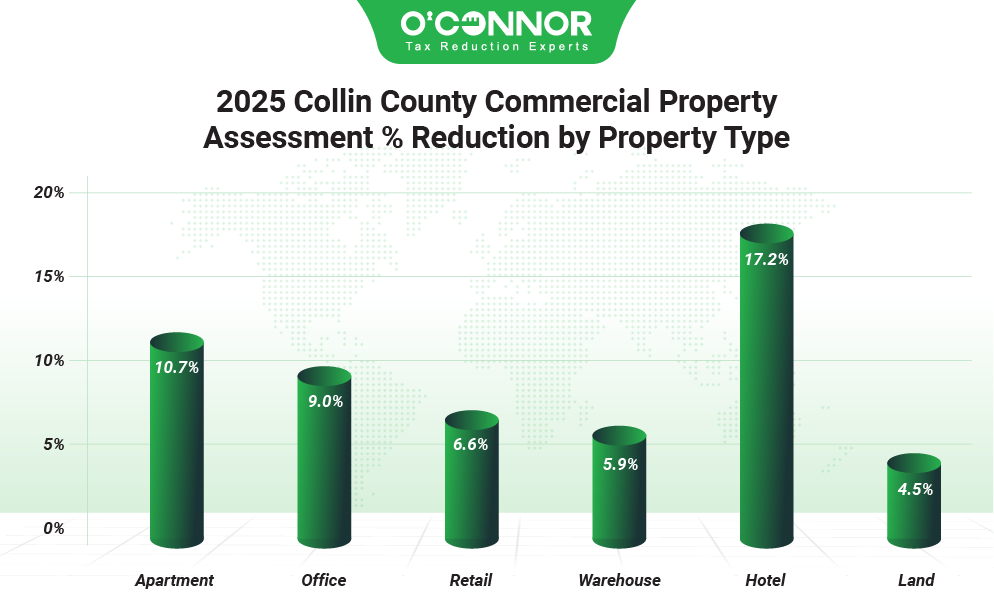
For urban and suburban counties, apartments and other multifamily residences are typically the largest block of commercial value. Collin County was no different, with $25.42 billion in value coming from them in 2025, after they were strongly cut down by 10.7%. Offices were easily in the No. 2 slot with $15.13 billion after protest reductions. Raw land was third with $14.43 billion after a small cut of 4.5%. Hotels had been the fastest riser with an increase of 40.5%, though this was reduced somewhat thanks to appeals, scoring a victory of 17.5%. Warehouses had initially added 26.3%, but were protested down by 5.9%, finishing with a total of $1.28 billion.
Offices Get 12.3% of Value Trimmed
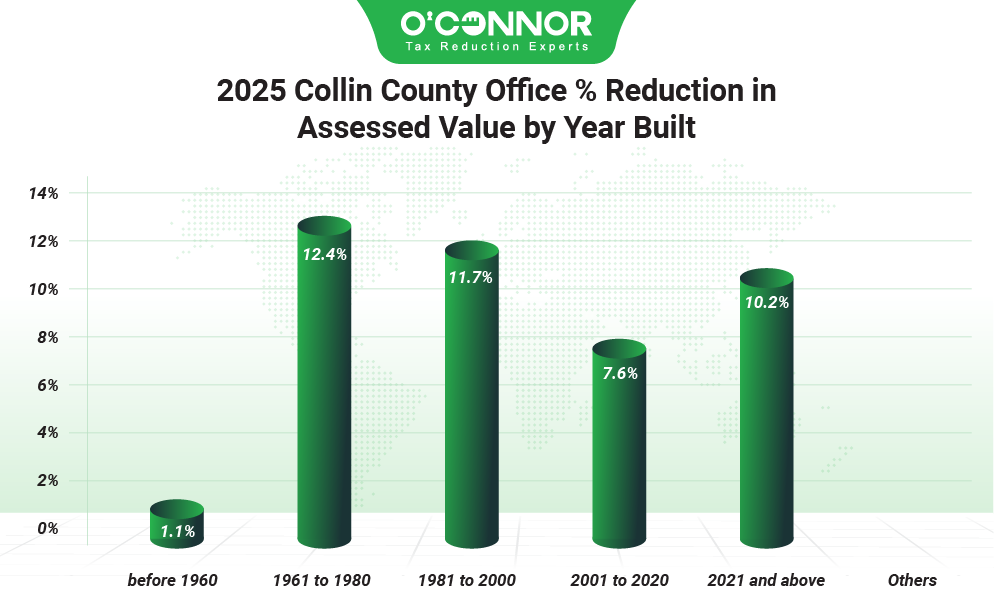
While not growing at the exponential rate of warehouses or hotels, offices are quickly becoming one of the most in-demand commercial properties in Collin County. Like most other property types, the majority of office value was generated in the boom period from 2001 to 2020, where 63% of value was built. Totaling $9.53 billion after a large a solid decrease of 7.6%, this timeframe was easily in the No. 1 spot. 26.5%, or $4.07 billion of the total came from offices built between 1981 and 2000, after a giant slice of 11.7% thanks to appeals. New construction was responsible for $1.45 billion after a savings of 10.2%. O’Connor was able to reap great rewards for our clients when it came to offices. Our customers knocked 12.3% off their total value, with those owners of properties built between 1981 and 2020, getting a huge return of 17.2%.
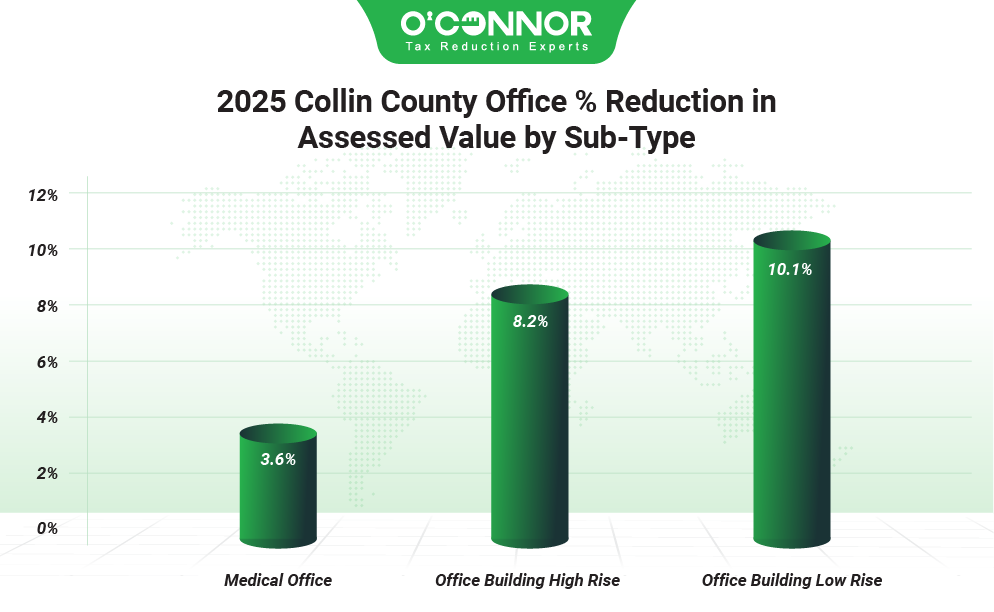
CCAD broke offices down into only three subtypes when it comes to assessments. Low-rise office buildings were by far the largest block with a value of $10.31 billion after a large decrease of 10.1% thanks to appeals. High-rise buildings were easily in second place and after a cut of 8.2%, they managed a grand total of $3.07 billion. Medical offices were last in value and reached $1.74 billion after a small reduction of 3.6%.
Appeals Were the MVP in Collin County
The staggering values and taxes of Collin County are only increasing, which means taxpayers are scrambling for a way to mitigate them. While it is common in Texas to use exemptions to help manage taxes, appeals or protests are being considered more and more each year. While these were originally only for businesses and the wealthy, more homeowners are turning to appeals of various types to even things out in their struggle against CCAD. In 2023, 26.73% of properties in Collin County were protested.
2025 demonstrates why appeals are so important for properties of all types. Homeowners were able to knock 0.9% of value from their properties, while businesses salvaged 8.7%. These were in the face of increases of 4.9% and 14.8% respectively. While this makes the protests look small on paper, it still represented a combined savings of $7.89 billion in taxable value, including $6.21 billion for commercial properties alone. This could be the difference between homes being kept or businesses being shuttered and this also keeps CCAD honest.
Those that joined us at O’Connor saw even better results, but that should not detract from those that worked hard on their appeals. Homeowners saved 1.4%, while commercial owners did even better with 9.6%. When put together, our clients managed to shave off $114.31 million off their tax burden, leading to lower levies in most cases. When you use O’Connor for your protest needs, you will never be charged an upfront fee or endure any other hidden costs. You only pay a contingency fee if you lower your taxes. Best of all, we at O’Connor will protest your taxes for you annually at no charge as well. This allows you to stack your victories on top of one another, opening the door for future savings. We do this for all our 185,000 clients and see it as the best way to bring in savings every year.

